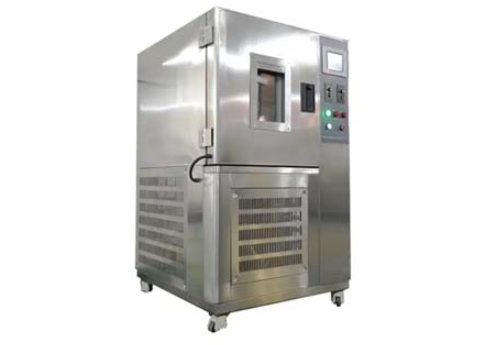Time: Popularity:0times
The Air-Ventilation Aging Test Chamber is a laboratory instrument specifically designed to evaluate the long-term performance and durability of materials under controlled high-temperature conditions with uniform airflow. By providing a ventilated environment, the chamber accelerates aging processes, allowing manufacturers and researchers to assess material stability, thermal resistance, and performance changes in a fraction of the time required for real-world exposure.

This type of chamber is widely used in industries such as plastics, rubber, coatings, textiles, electronics, automotive components, and composites. It provides a reliable, repeatable, and cost-effective method to predict how materials respond to high-temperature aging over time.
The Air-Ventilation Aging Test Chamber works by combining controlled high-temperature heating with forced air circulation:
Controlled heating: The chamber raises the interior temperature to a set level, simulating accelerated thermal aging.
Uniform airflow: A built-in ventilation system circulates hot air evenly across all samples, preventing localized hot spots and ensuring consistent aging.
Monitoring and data collection: Temperature sensors and a digital control system continuously monitor chamber conditions. Test duration, temperature cycles, and aging parameters are logged automatically.
Material evaluation: The chamber allows for the assessment of physical, mechanical, and chemical changes, including color change, hardness, deformation, tensile strength, and thermal degradation.
Key Features:
Programmable temperature control and cycling
Ventilated airflow for uniform exposure
Digital monitoring and automatic logging
Safety features for overheating and fan malfunction
The Air-Ventilation Aging Test Chamber is versatile and can be used for a wide range of applications:
Plastics and Rubber: Evaluate heat resistance, thermal degradation, discoloration, shrinkage, and mechanical property changes.
Coatings and Paints: Assess adhesion, gloss retention, hardness, and chemical stability after high-temperature exposure.
Electronics and Automotive Components: Test thermal reliability of circuit boards, connectors, sensors, and other heat-sensitive parts.
Textiles and Composite Materials: Examine dimensional stability, strength retention, and degradation under dry heat conditions.
This chamber is particularly valuable for R&D testing, quality control, and compliance verification across industries that require predictable material performance under elevated temperature conditions.
The Air-Ventilation Aging Test Chamber can be configured to meet international and regional standards, ensuring that testing results are valid and recognized:
ASTM D3045 – Standard Practice for Heat Aging of Plastics
ISO 188 – Rubber – Accelerated Aging and Heat Resistance
GB/T 1690 – Plastics – Determination of Long-Term Thermal Properties
IEC 60068-2-2 – Environmental Testing for Electronic Components
These standards define temperature ranges, test durations, and material evaluation methods, making the chamber suitable for both laboratory testing and industrial quality assurance.
Advantages:
Uniform heat distribution with forced ventilation ensures consistent results
High temperature accuracy and digital monitoring improve test reliability
Accelerates material aging, shortening development cycles
Suitable for a broad range of materials including plastics, rubber, coatings, and electronics
Limitations:
Does not simulate UV light or outdoor solar radiation
Cannot test humidity or condensation effects (requires a separate temperature-humidity chamber)
Requires regular maintenance of fans and heating elements to ensure consistent airflow
Q1: What types of materials can be tested in this chamber?
Plastics, rubber, coatings, textiles, electronic components, automotive parts, and composite materials.
Q2: Can it simulate humid conditions?
No. This chamber is specifically designed for dry heat aging. For humidity simulation, a combined temperature-humidity chamber is recommended.
Q3: How long does a typical test take?
Test duration varies depending on the material and test standard. Typical cycles range from 24 hours to several weeks.
Q4: Can the chamber be customized?
Yes. Temperature range, airflow speed, chamber size, and programmable cycles can be tailored to your testing requirements.
Q5: How should the chamber be maintained?
Inspect fans, heating elements, and sensors regularly.
Clean and calibrate periodically to maintain accurate temperature and airflow.
Replace worn components to prevent inconsistencies in test results.
We are a professional manufacturer and solution provider for testing instruments, offering:
Customizable solutions: Tailored temperature ranges, chamber sizes, and airflow programs.
Full-service support: From R&D and production to installation and after-sales service.
Expert technical guidance: Helping clients optimize testing procedures and improve material reliability.
Reliable results: Accurate, repeatable, and standardized testing for plastics, rubber, coatings, electronics, and composites.
Our Air-Ventilation Aging Test Chambers help clients predict material durability, enhance product quality, and reduce risk of failure, supporting both R&D and industrial production needs.
Company Phone
+86-21-6420 0566
Working hours
Monday to Friday
Mobile phone:
13816217984
Email:
info@qinsun-lab.com
